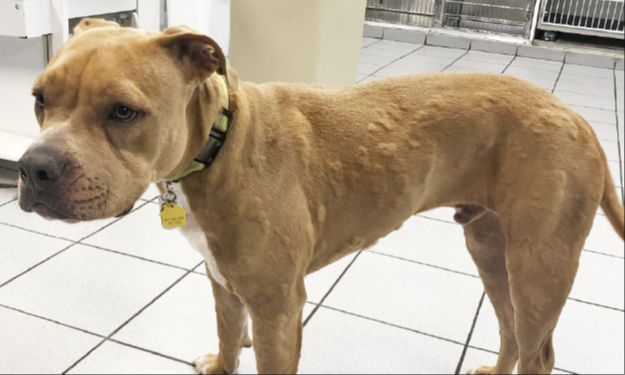Introduction
Allergies are very common in dogs, with about 10-15% of all dogs suffering from some type of allergy. Allergies can significantly impact a dog’s quality of life and comfort. Determining if a dog’s allergies are caused by environmental factors or food is important, because the treatment and management will differ depending on the cause.
Environmental allergies, also called atopic dermatitis, are caused by allergens in the air, surfaces, plants, or materials that irritate the dog’s immune system. These allergies account for about 80% of canine allergies. Food allergies occur when a dog’s immune system overreacts to a particular protein or ingredient in their food, which accounts for about 10% of dog allergies.
Identifying whether a dog has environmental or food allergies is critical for providing the right treatment plan and relief for the dog. While both may have similar symptoms, the management and prevention differs. Properly diagnosing the allergy can dramatically improve a dog’s quality of life.
Symptoms
Common symptoms of both environmental and food allergies in dogs include:
-
Itching and scratching – Dogs may scratch, bite, or lick at their skin constantly due to the irritation and inflammation caused by allergic reactions.
-
Hives – Allergic reactions can cause the development of small, raised bumps on the skin known as hives or wheals.
-
Ear infections – The moisture and warmth inside a dog’s ears makes them prone to infections when allergies cause inflammation.
-
Paw chewing/licking – Dogs may excessively lick or chew at their paws in response to itchiness or irritation caused by allergies.
-
Diarrhea – Some dogs may experience loose stools or diarrhea as a result of allergic reactions in their gastrointestinal tract.
-
Vomiting – Inflammation in the GI tract from allergies can also lead to vomiting in some cases.

The specific symptoms and their severity can vary between individual dogs. It’s important to monitor your dog closely if you suspect they may have allergies.
Environmental Allergies
Environmental allergies in dogs are caused by substances like pollen, mold spores, dust mites, and other airborne allergens. These allergens can cause an overreaction of the immune system when inhaled or exposed to the skin. Unlike food allergies, environmental allergies tend to follow seasonal allergy patterns. They also tend to affect areas of the dog’s body that are more exposed to the allergens, such as the paws, ears, muzzle, underarms, and around the rectum.
The most common symptoms of environmental allergies include itchy skin, recurrent ear infections, and skin irritations like hives or rashes. Dogs with environmental allergies will often lick and chew at their paws constantly. You may notice more symptoms during peak allergy seasons in spring, summer, or fall when pollen and mold levels are higher.

Environmental allergies can develop at any age, though they often begin earlier in a dog’s life around 1-3 years old. Certain breeds seem more prone to environmental allergies, including Labrador Retrievers, Golden Retrievers, Bulldogs, Poodles, Dalmatians, and Terriers.
Food Allergies
Food allergies in dogs are caused by ingredients like proteins, grains, and preservatives in their diet. Unlike environmental allergies, food allergies are present year-round rather than being seasonal. Food allergies primarily affect a dog’s digestive system.
The ingredients that most commonly cause allergic reactions in dogs are proteins like beef, dairy, chicken, lamb, fish, eggs, and soy. Grains like wheat, corn and white rice can also trigger allergies. Preservatives, additives, and coloring used in some pet foods may cause issues as well.
With food allergies, a dog’s immune system overreacts to the ingredients their body perceives as foreign. This causes inflammation and leads to symptoms mostly related to the gastrointestinal tract. Dogs may experience vomiting, diarrhea, bloating, gas, and abdominal pain. There may also be itchy skin, hot spots, and ear infections.
Food allergies can develop at any age, but are more common in young dogs under age 2. Certain breeds like Golden Retrievers, Labradors, German Shepherds, and Cocker Spaniels are at higher risk. Unlike environmental allergies which are seasonal, food allergy symptoms persist year-round.
Diagnosing food allergies requires an elimination diet trial for 8-12 weeks to identify trigger ingredients. Treatment involves identifying and avoiding the problematic ingredients in the dog’s diet. Medications and supplements may help manage symptoms.
Feeding a hypoallergenic formula with limited ingredients can help prevent food allergies. High-quality diets with whole protein sources tend to cause fewer allergic reactions as well. Working closely with your vet can help determine the best diet and treatment for your dog’s food allergies.
Diagnosis
Diagnosing whether your dog has environmental allergies or food allergies starts with a thorough review of their medical history and symptoms by your veterinarian. They will want to know when symptoms started, how long they have persisted, seasonality, and what seems to trigger flare ups. Be prepared to provide a detailed timeline.
Your vet may recommend an elimination diet trial, where your dog is fed a novel protein and carbohydrate diet, like duck and potato, for 8-12 weeks. If symptoms improve, then it indicates a food allergy. Your vet may then reintroduce ingredients one at a time to isolate the allergen.

Allergy testing is another diagnostic option. Your vet may recommend a blood test that checks for antibodies to common environmental or food allergens. Skin allergy testing is also available. It works by injecting small amounts of suspected allergens into your dog’s skin and measuring the response.
In some cases, your vet may need to combine testing methods to definitively diagnose the cause of your dog’s allergies. But determining if environmental irritants or food are to blame is key for effective treatment.
Treating Environmental Allergies
If your dog has environmental allergies, treatment focuses on avoiding or reducing exposure to whatever they’re allergic to. Some options include:
- Keeping your dog indoors when pollen and mold counts are high.
- Using high efficiency filters in your home’s HVAC system.
- Washing your dog’s paws after being outside to remove allergens.
- Bathing your dog regularly with shampoo formulated for dogs with allergies.
Medications can also help relieve allergy symptoms. Antihistamines like Benadryl can reduce itchiness. Talk to your vet before giving any medication to your dog. Steroids may be prescribed for short-term relief of severe symptoms.
Allergy shots called immunotherapy can help desensitize your dog to environmental allergens over time. This involves giving your dog regular injections of small amounts of the allergen to build up tolerance. Immunotherapy can take months to fully work but can provide long-term relief.
Treating Food Allergies
If your dog has a food allergy, the most effective treatment is to put them on an elimination diet to identify which ingredients are causing the allergic reaction. This involves feeding your dog a prescription hypoallergenic diet containing proteins and carbohydrates they have never eaten before. Your vet can provide you with prescription hypoallergenic dog food options.
It’s critical to carefully check the ingredient labels for all food, treats, and chews when your dog is on an elimination diet trial. Make sure your dog is not exposed to any other proteins or ingredients other than the prescription hypoallergenic diet. This strict elimination diet trial typically needs to last 8-12 weeks to see improvement in your dog’s symptoms.
Once your vet determines your dog’s unique food allergens, you can look for prescription or over-the-counter limited ingredient dog foods that avoid those problem ingredients. Continuous careful monitoring of food labels is essential to prevent exposure to ingredients your dog is allergic to. Some dogs need to stay on prescription hypoallergenic food long-term if their food allergies are severe.
Prevention
There are several things you can do to help prevent allergic reactions in your dog:
Bathe and groom regularly – Bathing your dog at least once a week can reduce airborne allergens on their skin and coat. Be sure to use a mild, hypoallergenic shampoo. Regular brushing and grooming also helps remove allergens.

Use HEPA air purifiers – HEPA air purifiers can filter out pollen, dust mites, and other allergens from the air. Having HEPA filters in your home can reduce allergens that irritate your dog’s skin or respiratory system.
Give probiotics – Probiotic supplements support digestive and immune system health in dogs. They can help reduce inflammation associated with allergies. Ask your vet for a recommended probiotic.
Feed a high-quality diet – Some dogs have food sensitivities that contribute to skin or gastrointestinal issues. Feeding a hypoallergenic, limited-ingredient diet recommended by your vet can reduce reactions.
When to See a Vet
In some cases, the symptoms of dog allergies may become severe enough that you need to take your dog to the vet. Here are some signs that it’s time for a professional evaluation and treatment:
-
Symptoms are severe or chronic – If your dog is constantly itching, has open sores, or seems extremely uncomfortable despite your efforts to manage allergies at home, it’s important to seek veterinary care. Severe, ongoing allergies can seriously impact your dog’s quality of life.
-
Allergy testing needed – To definitively diagnose environmental or food allergies in dogs, allergy testing is often required. This may involve skin or blood tests. Your vet can help determine which specialized testing is recommended for your dog.
-
Prescription medications required – For moderate to severe dog allergies, prescription medications may be necessary for adequate relief. Your vet can prescribe medications like steroids, antihistamines, immunosuppressants, or allergen-specific immunotherapy that are much stronger than over-the-counter options.
Don’t hesitate to make a vet appointment if your dog’s allergies are not well-controlled with initial attempts to reduce allergens or use OTC meds. With the right testing and treatment, most dogs can achieve noticeable improvement in their allergy symptoms and comfort.
Summary
The key differences between environmental and food allergies in dogs come down to the triggers. Environmental allergies are caused by things like pollen, dust mites, and mold spores in the air. Food allergies are triggered by ingredients in your dog’s diet, like certain proteins or grains. Identifying the specific allergen is crucial so you can take steps to avoid those triggers.
Treatment focuses on avoiding exposure to allergens as much as possible. For environmental allergies, this may mean more frequent bathing, wiping paws after going outside, using air filters, etc. For food allergies, it means transitioning to a hypoallergenic dog food. Medications can also help manage symptoms for both types of allergies.
While allergies can’t be cured, with vigilance over triggers and proper treatment under a vet’s supervision, both environmental and food allergies can be managed for your dog’s comfort.